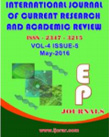Abstract Volume:4 Issue-5 Year-2016 Original Research Articles
 |
Online ISSN : 2347 - 3215 Issues : 12 per year Publisher : Excellent Publishers Email : editorijcret@gmail.com |
To study the antimicrobial activity, algal and cyanobacterial species like Anabaena aequalis, Lyngbya aestuarii, Oscillatoria angusta, Spirulina laxa and Synechocystis aquatilis were selected. Antimicrobial and antifungal activities of algal extracts were tested by agar well difffusion method. In addition, comparing the antimicrobial activity of cyanobacteria and algae with standard antibiotics (Amoxicillin and Polynoxylin) were also done. From the present study, it is clearly evident that all the algal extracts (both methanol and water) had inhibitory effect on the microbes even though the percentage of inhibition varied. Among the methanol extracts, L. aestuarii extract showed maximum inhibitory effect against both E. coli and S. faecalis. However, among the water extracts, even though L. aestuarii again recorded maximal inhibitory effect against E. coli. Among all the algal species examined, the highest amount of the quercetin was found in S. aquatilis (42 mg/l). Estimation of phycocyanin content also suggests that the maximum content was found in S. aquatilis. It can be concluded that the antibacterial activity of the algae depends on the content of quercitin and phycocyanin pigments for the alcohol extracts and polysaccharide content for the water extracts.
How to cite this article:
Sugumar, R., and Anandharaj, B. 2016. Study on Antimicrobial Activity of Algal Isolated from a Freshwater LakeInt.J.Curr.Res.Aca.Rev. 4(5): 112-121doi: http://dx.doi.org/10.20546/ijcrar.2016.405.011



Quick Navigation
- Print Article
- Full Text PDF
- How to Cite this Article
- on Google
- on Google Scholor
- Citation Alert By Google Scholar
